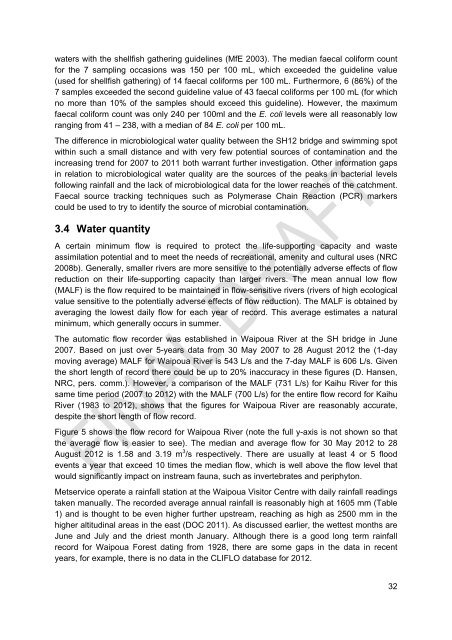Waipoua River 20130219.pdf - Northland Regional Council
Waipoua River 20130219.pdf - Northland Regional Council
Waipoua River 20130219.pdf - Northland Regional Council
- No tags were found...
Create successful ePaper yourself
Turn your PDF publications into a flip-book with our unique Google optimized e-Paper software.
waters with the shellfish gathering guidelines (MfE 2003). The median faecal coliform countfor the 7 sampling occasions was 150 per 100 mL, which exceeded the guideline value(used for shellfish gathering) of 14 faecal coliforms per 100 mL. Furthermore, 6 (86%) of the7 samples exceeded the second guideline value of 43 faecal coliforms per 100 mL (for whichno more than 10% of the samples should exceed this guideline). However, the maximumfaecal coliform count was only 240 per 100ml and the E. coli levels were all reasonably lowranging from 41 – 238, with a median of 84 E. coli per 100 mL.The difference in microbiological water quality between the SH12 bridge and swimming spotwithin such a small distance and with very few potential sources of contamination and theincreasing trend for 2007 to 2011 both warrant further investigation. Other information gapsin relation to microbiological water quality are the sources of the peaks in bacterial levelsfollowing rainfall and the lack of microbiological data for the lower reaches of the catchment.Faecal source tracking techniques such as Polymerase Chain Reaction (PCR) markerscould be used to try to identify the source of microbial contamination.3.4 Water quantityA certain minimum flow is required to protect the life-supporting capacity and wasteassimilation potential and to meet the needs of recreational, amenity and cultural uses (NRC2008b). Generally, smaller rivers are more sensitive to the potentially adverse effects of flowreduction on their life-supporting capacity than larger rivers. The mean annual low flow(MALF) is the flow required to be maintained in flow-sensitive rivers (rivers of high ecologicalvalue sensitive to the potentially adverse effects of flow reduction). The MALF is obtained byaveraging the lowest daily flow for each year of record. This average estimates a naturalminimum, which generally occurs in summer.The automatic flow recorder was established in <strong>Waipoua</strong> <strong>River</strong> at the SH bridge in June2007. Based on just over 5-years data from 30 May 2007 to 28 August 2012 the (1-daymoving average) MALF for <strong>Waipoua</strong> <strong>River</strong> is 543 L/s and the 7-day MALF is 606 L/s. Giventhe short length of record there could be up to 20% inaccuracy in these figures (D. Hansen,NRC, pers. comm.). However, a comparison of the MALF (731 L/s) for Kaihu <strong>River</strong> for thissame time period (2007 to 2012) with the MALF (700 L/s) for the entire flow record for Kaihu<strong>River</strong> (1983 to 2012), shows that the figures for <strong>Waipoua</strong> <strong>River</strong> are reasonably accurate,despite the short length of flow record.Figure 5 shows the flow record for <strong>Waipoua</strong> <strong>River</strong> (note the full y-axis is not shown so thatthe average flow is easier to see). The median and average flow for 30 May 2012 to 28August 2012 is 1.58 and 3.19 m 3 /s respectively. There are usually at least 4 or 5 floodevents a year that exceed 10 times the median flow, which is well above the flow level thatwould significantly impact on instream fauna, such as invertebrates and periphyton.Metservice operate a rainfall station at the <strong>Waipoua</strong> Visitor Centre with daily rainfall readingstaken manually. The recorded average annual rainfall is reasonably high at 1605 mm (Table1) and is thought to be even higher further upstream, reaching as high as 2500 mm in thehigher altitudinal areas in the east (DOC 2011). As discussed earlier, the wettest months areJune and July and the driest month January. Although there is a good long term rainfallrecord for <strong>Waipoua</strong> Forest dating from 1928, there are some gaps in the data in recentyears, for example, there is no data in the CLIFLO database for 2012.32
















